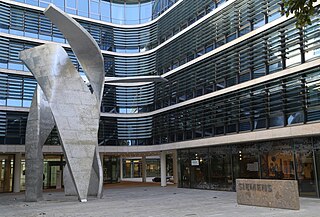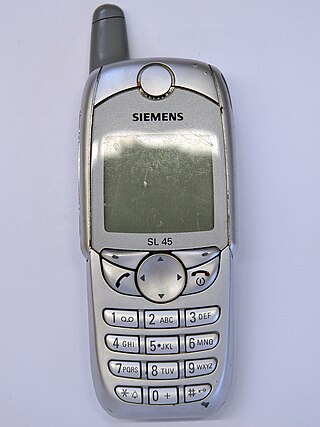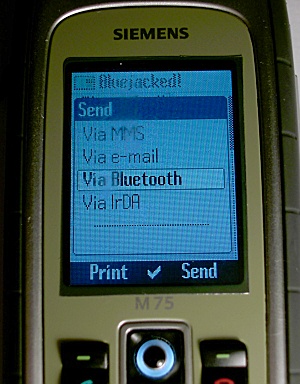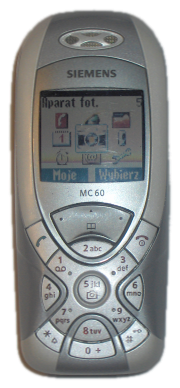
Nokia Corporation is a Finnish multinational telecommunications, information technology, and consumer electronics corporation, established in 1865. Nokia's main headquarters are in Espoo, Finland, in the greater Helsinki metropolitan area, but the company's actual roots are in the Tampere region of Pirkanmaa. In 2020, Nokia employed approximately 92,000 people across over 100 countries, did business in more than 130 countries, and reported annual revenues of around €23 billion. Nokia is a public limited company listed on the Helsinki Stock Exchange and New York Stock Exchange. It is the world's 415th-largest company measured by 2016 revenues according to the Fortune Global 500, having peaked at 85th place in 2009. It is a component of the Euro Stoxx 50 stock market index.

Siemens AG is a German multinational conglomerate corporation and the largest industrial manufacturing company in Europe headquartered in Munich with branch offices abroad.

Siemens Mobile was a German mobile phone manufacturer and a division of Siemens AG. Siemens sold Siemens Mobile to the Taiwan-based BenQ in 2005, subsequently becoming BenQ-Siemens and succeeded by Gigaset. The last Siemens-branded mobile phones, the AL21, A31 and AF51, were released in November 2005.

The Siemens SL45 was the first mobile phone with memory expansion and an MP3 player, which debuted in 2001. An improved version, the SL45i, was also the first phone to have a Java virtual machine.
The Siemens S40 is a mobile phone. Originally developed as the Bosch 1886 in 2000, the phone was branded as the Siemens S40 after Siemens acquired the Bosch mobile phone division. The Siemens S40 is a tri-band mobile phone that operates on the GSM-900, GSM-1800, and GSM-1900 networks. Communication with a computer can be done either through the infrared port (IrDA) on the phone or a USB or serial port data cable. Its more distinctive features include the voice memo recorder, the mute feature for conversations, the ability to record phone conversations, and the ringtone composer.

The Siemens M75, this is the successor of Siemens M65. The phone released in 2005, is manufactured by BenQ Mobile. It is one of the few mobile phones to be weather and shock resistant, while not skimping on other features like a 1.3MP digital camera, 262k color screen and a digital music player supporting the MP3 and AAC formats. It comes in 2 color variants, safari green and black.

BenQ Mobile GmbH & Co. OHG was the mobile communications subsidiary of Taiwanese BenQ Corporation, selling products under the BenQ-Siemens brand. The group, based in Munich, Germany, was formed out of BenQ's acquisition of the then struggling Siemens Mobile group in 2005. The newly formed company won the most iF product design awards in 2006 and also won many design awards in Germany's Red Dot competition. BenQ Mobile failed later that year.

The Siemens MC60 was a mobile phone sold by Siemens. It weighs 86 g and has improved resistance to water, shock and dust when compared with previous models. The phone also includes digital imaging and picture messaging. Its integrated camera takes pictures simply by holding the 5 key, then pressing it again. The Siemens MC60 has a number of pre-installed polyphonic ring tones, additionally own ringtones can be recorded.
BenQ-Siemens SL91 is a slider-type GSM 3G mobile phone, created by BenQ Mobile and introduced in July 2006. The SL91 phone is the successor of Siemens SL75 and BenQ-Siemens SL80. this phones was stylish slider drawing inspiration and development from the previous Siemens Mobile”SL family“ Siemens SL55. SL65 and Siemens SL75.

ROLM Corporation was a technology company founded in Silicon Valley in 1969. IBM Corp. partnered with the company, and ROLM Mil-Spec was sold to Loral Corporation and later to Lockheed Martin in 1996 as Tactical Defense Systems. IBM's ROLM division was later half sold to Siemens AG in 1989, whereupon the manufacturing and development became wholly owned by Siemens and called ROLM Systems, while marketing and service became a joint venture of IBM with Siemens, called ROLM Company. After nearly 30 years, phone products with the name "Rolm" were discontinued in the late 1990s, as sales dropped in markets dominated by new technology with other products or other companies.

The Siemens CX75 was released in 2005, and is a mobile phone manufactured by BenQ Mobile.

The Radio Telephone Network C, was a first generation analog cellular phone system deployed and operated in Germany by DeTeMobil. It utilized the C-450 standard, originally developed by Siemens AG, and was the third and last update of a series of analog mobile phone systems used primarily within Germany, superseding the B-Netz and the A-Netz before it. It has been decommissioned, replaced by both the newer D-Netz and E-Netz systems, both based on GSM standards and operating on 900 MHz and 1800 MHz bands respectively.

The Siemens C75 is a mobile phone sold by Siemens. The C75 is a triband cameraphone. It weighs 85 g and dimensions are 103 x 44 x 17 mm. It includes GPRS class 10 connections with WAP 2.0 capability and IrDA. It supports polyphonic ringtones in MIDI and WAV formats. It has 10,2 MB of onboard memory available for the user. The phone also includes digital imaging and picture messaging. It has a built-in camera capable of taking pictures in VGA resolution and recording videos. It also supports SMS archiving.

BenQ Corporation is a Taiwanese multinational company that sells and markets technology products, consumer electronics, computing and communications devices under the "BenQ" brand name, which stands for the company slogan Bringing Enjoyment NQuality to life. Its principal products include TFT LCD monitors, digital projectors, digital cameras, and mobile computing devices.
The Siemens C25 is a mobile phone introduced by Siemens in 1999.Siemens C 25 is positioned as an entry-level model. It is a small, lightweight, handy device. This model was available in only 5 colors. But it was possible to buy a removable front panel.

The Siemens AX72 is a mobile phone introduced by Siemens in October, 2005. It weighs 79 g and its dimensions are 105,6 x 46,8 x 17,5 mm. Its display a CSTN 65K colors LCD.

The Siemens C65 is a mobile phone announced by Siemens. This phone is under “C-Class” leveling of Siemens for entry levels/ consumer regularly. Its been released in March 2004. It weighs 86 g and its dimensions are 100 x 45 x 16 mm. Its display is a 130x130 pixels, 65K colors CSTN LCD. Its carrier-engineered variants are Siemens CT65, CV65 and CO65, exclusively for three mainly mobile operators T-Mobile, Vodafone and O2 respectively. It is known in North America as the Siemens C66.
The form factor of a mobile phone is its size, shape, and style, as well as the layout and position of its major components.














